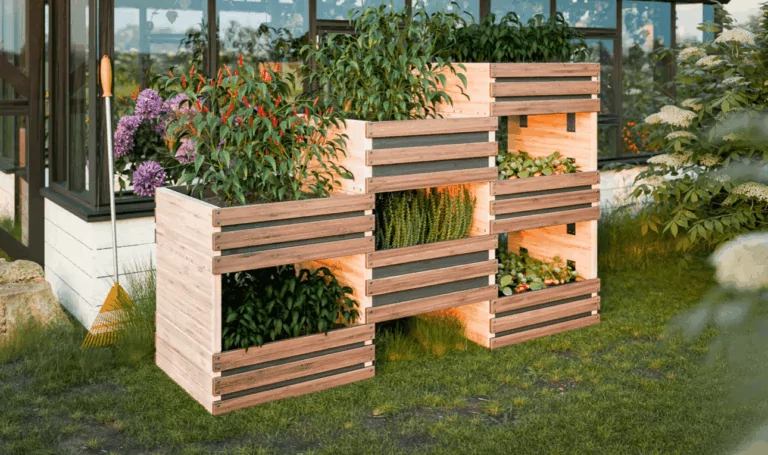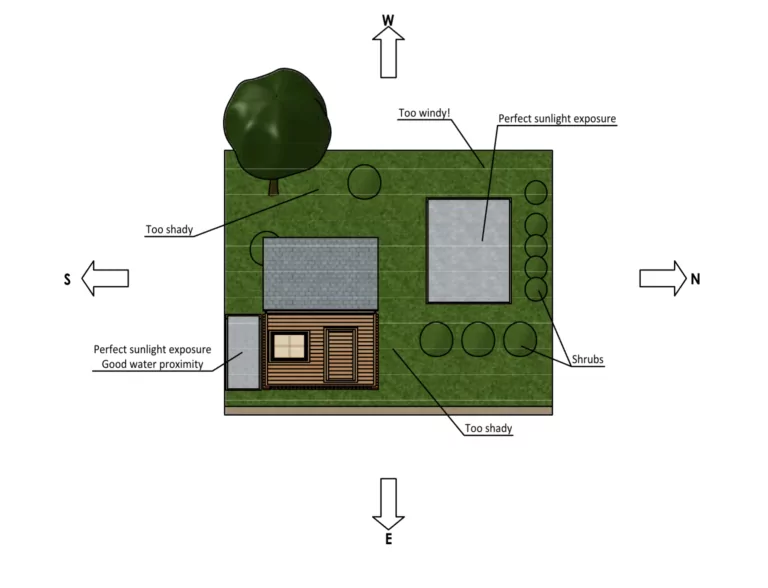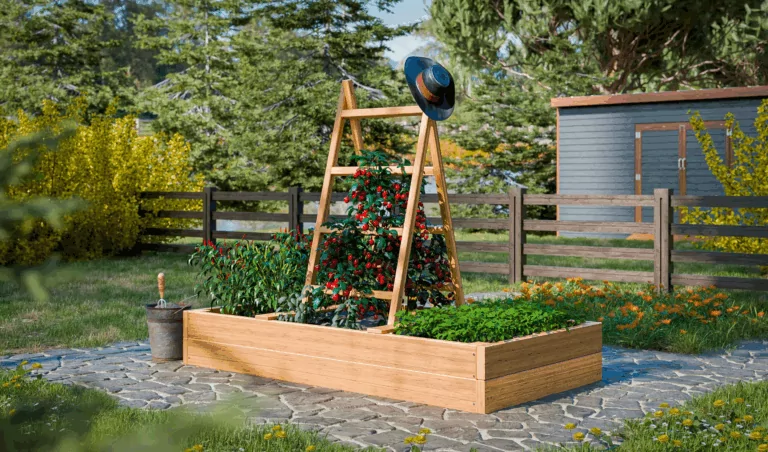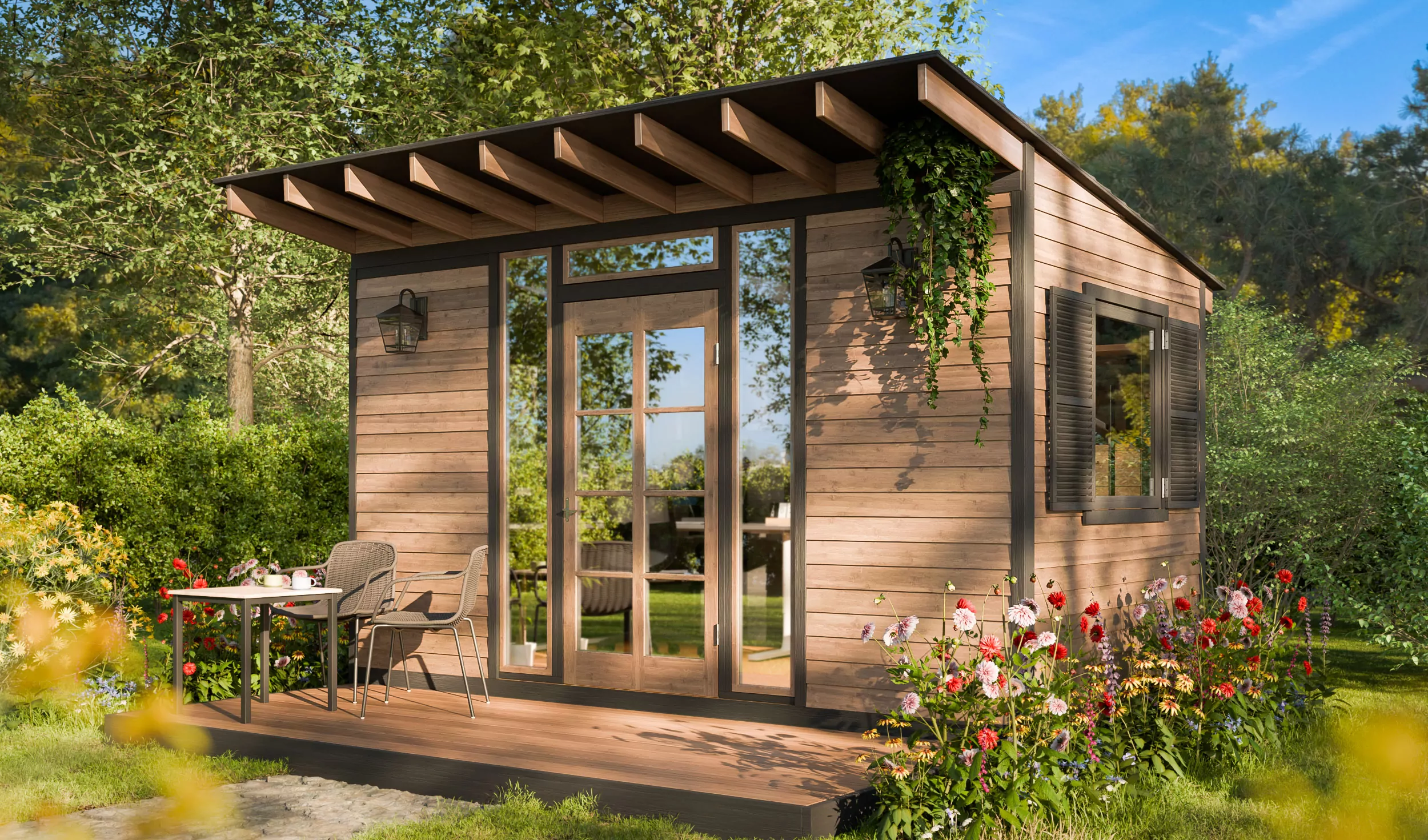Above-ground gardening uses raised garden beds to grow vegetables or flowers. You can control the soil and weeds more easily, and working with raised beds is better for your back. What is a raised garden bed made of? You can use various materials to build a raised garden bed, or you can purchase ready-made beds.
If you plan on feeding your family for the season, you’ll need about 200 square feet of garden space per person, depending on how often you eat vegetables and the type of vegetables you plant.
Why Choose Raised Bed Gardening? (Benefits vs. In-Ground)
Raised bed gardening has many benefits over in-ground gardening. A raised vegetable garden allows you to:
- Control Soil Quality: You can control soil quality much more easily with raised beds, as long as you start with good soil since it is contained within the beds and amendments can’t leech out into the ground and away from plants. Instead of using dirt from your property, purchase soil that has amendments. Depending on the size of the beds, use bagged soil or order screened mushroom dirt from a nursery or a company that provides truckloads of topsoil. You will need 32 cubic feet of soil to fill a 4-foot by 4-foot by 24-inch raised bed.
- Composting: Create a compost pile near your garden beds. The further you put it, the more distance you have to haul the compost. Ten to twenty feet away gives you plenty of room to work the pile. Start the pile with grass clippings, leaves and other organic matter. Keep the pile manageable for your abilities, as you will need to turn it every couple of weeks. You can always make a second pile if needed. Each year, you can easily amend the soil in raised beds with compost.
- Manage Weeds: Placing weed block under the raised beds helps minimize weeds.
- Control Pests: Moles burrow near plants, disturbing root systems, and voles chew the roots, causing you to lose your vegetable crop. One of the best raised-bed gardening tips is to place mole and vole barrier screening under the raised beds.
- Create an Extended Growing Season: Because the soil in raised beds stays warmer than the soil in the ground, you can plant earlier and harvest later. The temperature difference could be as much as 8 to 13 degrees warmer in raised beds, depending on factors such as soil type and temperature.
- Provides Accessibility: Gardening in raised beds provides accessibility for people of all ages and abilities.
- Flexible Aesthetics: Select materials and raised bed sizes that benefit your landscaping, especially if you plan to have multiple raised beds.

Benchtop raised garden with integrated workspace
Raised Bed Garden Designs & Layouts
There are many raised bed garden design ideas to explore. Depending on the available space, you can create a grid with several beds, make U-shaped beds, or tiered beds if the available footprint is small, such as a patio or small deck.
Because you can choose from various materials, you can match a raised bed vegetable garden design with your landscaping by choosing modern, rustic or even flower-focused designs. You can also choose raised beds made from wood, cement blocks, or metal.
If you have limited space, you need a tiered raised garden bed. Building more than one raised bed also allows you to create companion planting zones for various vegetables and flowers, which can enhance the aesthetics of your landscape.
Our raised bed garden layout pictures showcase several designs, including grids and companion planting zones.

How to Plan a Raised Bed Garden That Works
The first steps of raised bed garden planning are the most important. Before purchasing or building raised garden beds, determine the best location for them. You can even build raised beds on a slope as long as you level the tops of the beds – you don’t need to level the ground except for under the walls of the raised beds.
STEP 1: Choose a Sunny Location
Ensure the location for your raised beds has at least six to eight hours of sunlight. The more sun, the better. Also, account for strong winds and drainage. Your beds need to be able to drain, or you could lose your crop to root rot and other diseases.

STEP 2: Consider Water Access
How close are you to water? Do you plan to hand-water or use drip irrigation? The further away from water, the more expensive it will be to install a drip irrigation system.

STEP 3: Prepare the Ground
If you are building on a slope, you only need to dig or add soil to the area where the walls of the bed will rest so the top of the bed remains level. Lay out the weed block, and if necessary, install a mole and vole screen. Now is the ideal time to install drip irrigation, allowing you to bury the water lines easily.

STEP 4: Fill the Raised Beds With Soil and Start Planting
Build the raised beds, fill them with good soil, and plant your crops!

Some raised bed gardening tips include:
- Keep the tops of the beds as level as possible so that one area does not get more water than others.
- Know your raised bed measurements prior to working the ground. Each plan includes measurements for the overall size of the raised garden bed.
- Use string and a line level to mark the height of your beds to determine how much extra material you need to build on a slope.
How to Choose the Right Location?
Part of choosing the right location is ensuring the garden receives enough sunlight and drainage. You should also place them close to a water source so you won’t have to lug water or run a few hundred feet of water line.

What Tools and Materials Do You Need to Start?
Before starting raised garden bed construction, ensure you have the proper tools and materials. If you are using our plans to create garden beds, you will receive a list of materials and their corresponding sizes.
Depending on what materials you use, you’ll need a variety of tools, including:
- Screwdrivers
- Drill
- Saw
- Hammer
- Level
- Angle square, square or speed square
- Weed block
- Mole or vole screen
- Shovel
- Trowel
- Sockets, if working with metal and nuts and bolts, instead of screws
Wood for Raised Garden Beds
When planning a raised garden bed, choosing the right wood is crucial for both longevity and safety. Cedar and redwood stand out as premium options due to their natural rot resistance and safety when left untreated. While these materials come with a higher price tag, their durability makes them worthwhile investments – cedar typically lasting 5-25 years and redwood enduring 10-30 years depending on environmental conditions.
For a comprehensive guide on selecting the best wood for raised garden beds, including budget-friendly alternatives and treatment options, explore this comparison of wood types for raised garden beds.
How Many Raised Beds Do You Need?
The number of raised beds you can have depends on space constraints and how much work you are able to do in the gardens.
With a single raised bed vegetable garden, everything is in one large bed. Modular beds are smaller beds that you can put next to each other to create grids, a U-shaped bed, or even place them in different areas of the lawn.
Another benefit of modular beds is that you can move them each year. It is also easier to remove the soil and add new, should you need to.
Some vegetables do not grow well near others. For example, onions can stunt the growth of beans, so it is best to plant them in separate beds or at opposite ends of a large single bed.
What Type of Soil Should You Use in a Raised Bed?
The soil for raised beds should be a mixture of topsoil, compost and amendments. The mixture should be at least 50:50 topsoil and compost but can be two-thirds topsoil and one-third compost.
Be careful with the amount of compost you use, as it can create issues with water retention. It dries out quickly and actually repels water if it becomes too dry. However, the correct amount can help aerate the soil.
If the topsoil contains a lot of clay, mix in some sand to create a loamier texture. You can purchase quality topsoil in bulk from most garden centers. Avoid mostly clay or very sandy soil.
If your raised bed is higher than 2 feet, you can layer sticks, leaves, compost and soil to reduce costs. These materials break down, so you’ll need to add topsoil once or twice per year.
In most cases, you won’t need a barrier between the ground and the raised bed soil. However, weed block in taller beds and mole and vole screen can help manage weeds and pests.
Finally, ensure your soil has the proper pH for the plants you are growing, whether vegetables or flowers. Test the soil annually in both the fall and spring to determine when amendments are necessary. Testing empty beds in the fall allows you to add amendments so they can work over the winter. Testing in the spring prior to planting ensures you have the proper pH. Most vegetables require a pH range of 6.2 to 6.8, according to the University of Maryland.
What to Put in the Bottom of a Raised Garden Bed?
If you have a taller raised garden bed, you can fill the bottom with cardboard, gravel, weed barrier (weed block), sticks, or even logs. However, cardboard, sticks, leaves and other organic matter will decompose over time, so you’ll have to add more topsoil.
How Deep Should a Raised Bed Garden Be?
The minimum depth of a raised bed should be at least 18 inches. While you can go as narrow as 12 inches, certain plants may not have enough room.
The maximum depth should be no more than 4.5 to 5 feet, though this is more important if one side of the bed is against a wall—you need to be able to reach the back of the bed.
Also, when designing raised beds, be sure to leave at least the width of a wheelbarrow—approximately 27 inches—or a small lawn tractor—approximately 4.5 feet—between beds, so you have room to bring amendments and new plants in for each bed. This is more important when you have a grid of raised beds.
How Tall Should a Raised Garden Bed Be?
You can make your raised bed height as deep or shallow as you want it. People who have back problems or other physical limitations may prefer a raised bed that is at least 2 feet high. Some may prefer shallower beds set on the ground.
However, if you use shallower beds that are lower than 18 inches, you may need to till the ground beneath the bed, which defeats the purpose of using raised beds in cases where the soil is poor.
The height of your bed also affects the aesthetics of your landscaping. Taller beds may look more aesthetically pleasing in certain landscapes, while shorter beds may be more suitable in others.

What Vegetables Grow Best in Raised Garden Beds?
Certain vegetables love raised garden beds, including:
Leafy Greens
Leafy greens thrive in raised beds. You can even plant by season. Once warm-weather crops finish, rotate cool-weather crops, such as kale, into those beds.
Leafy greens that do well in raised beds include:
- Swiss chard
- Arugula
- Lettuce
- Kale
- Purple mustard
- Mizuna
- Spinach
- Romaine
- Spring mix
Root Crops
Certain root crops also thrive, including beets, carrots, and radishes. Carrots will love the looser soil, as they do not do well in more compact soils.
Fruiting Crops
Small fruiting plants—those that do not take a lot of root space or vining space—also do well in raised beds. They have enough room for their roots to spread out and are pickier about their soil. Modular raised beds allow you to amend the soil according to each crop’s preference.
You can train many fruiting plants to use a trellis in a raised vegetable garden, which keeps them off the ground—another plus. Some of the best fruiting plants to put into raised beds include:
- Cherry tomatoes
- Beans
- Okra
- Cucumbers
- Small eggplant
- Peppers
- Zucchini
- Squash
Because of the limited space, look for low-maintenance, high-yield crops for your beds.

What NOT to Plant in a Raised Bed
Some crops will outgrow beds, and these are the vegetables you should avoid. Vegetables such as corn, rhubarb, asparagus and large varieties of squash may not have enough room in raised beds unless you create a large bed.
Also, avoid introducing invasive plant species.
How to Build and Set Up a Raised Bed Garden
Once you have the layout for raised beds planned, it’s time to build and set up a raised garden bed.
STEP 1: Measure and cut the wood to the required dimensions. Our raised garden plans use several standard measurements, such as 4 feet by 8 feet. However, you can build them as large or as small as you wish. You should use 2-inch thick boards, as they will last longer than 1-inch thick boards; however, they are more expensive.
STEP 2: Assemble the frame. Secure boards with wood screws and brackets, as they will provide more support. Using a carpenter’s square, ensure that all corners are at a 90-degree angle (square) prior to securing the boards.
- Build the main frame
- Assemble the walls
- Fasten the walls using wood screws
STEP 3: Prepare the ground. When working on a slope, keep in mind that the top of the beds must be level from front to back, side to side, and with each other. You only need to excavate the area where the frame and wall of the bed sit.
Place a weed barrier under the bed. If you have trouble with moles or voles, add a metal screen barrier.
STEP 4: If you built taller raised beds, layer the bottom with cardboard, sticks, twigs, leaves and other organic materials. Be sure to avoid tarps and plastic, as they can hinder drainage.
STEP 5: Fill the bed with soil mix. To enhance draining, place perlite or sand on top of the organic matter at the bottom of the bed, then add compost and topsoil.
STEP 6: Plant vegetables or flowers. To ensure every plant receives enough sunlight, plant taller plants behind shorter ones to avoid blocking the sun, especially in early spring or late summer and early fall when the sun is lower in the sky.
Ensure you leave enough room between plants so they have room to grow.
How to Grow Vegetables in a Raised Bed Garden
Planting in raised beds is not much different than planting in the ground. You must still prepare the soil for planting each year. You should also rotate crops to minimize the risk of disease.
Plant seeds at the depth recommended on the packet. If you plant starter plants, be sure to dig a hole large enough to cover the entire root ball.
Check the plants for spacing, watering and light requirements. You won’t have to put such a large space between rows since you won’t need to get in there with a wheelbarrow or tractor. However, don’t plant vegetables, especially root crops, too close to the walls of the raised bed.
Ensure the plants receive plenty of water. To determine the watering frequency of your plants, you will need to know their specific water requirements, as each type of plant has distinct needs. You can test the soil by sticking your finger into it to determine its dryness. We recommend checking soil moisture daily and watering as needed.
Finally, ensure that you place the raised gardening bed in a spot that receives at least six hours of sunlight per day.
Raised Bed Gardening Dos and Don’ts
Follow these raised bed gardening tips for beginners:
- DON’T limit bed length. You can make them as long or as short as you wish.
- DO consider irrigation options prior to filling raised beds.
- DO consider space between the beds—you should leave enough space to get a wheelbarrow or small tractor between the beds.
- DON’T plant perennials in a raised bed, especially if you use filler in the bottom. The filler decomposes, which means you must add more soil, a process that can be impossible without disturbing the plants.
- DO amend the soil every year prior to planting.
Frequently Asked Questions About Raised Bed Gardening
1. What is the best thing to plant in a raised garden bed?
The best plants to put in raised garden beds are annuals—those that you must replant every year. They may be flowers or vegetables. However, if the raised bed is low to the ground and you do not use organic matter as filler, you could plant perennials in a raised bed.
2. Can I build a raised bed on concrete?
Yes, you can build a raised bed on concrete, but you will need a taller bed to ensure plants have enough growing space.
3. How do I start a raised bed garden from scratch?
To start a raised bed garden from scratch:
- Plan the location
- Prepare the ground
- Build or purchase the beds
- Install the beds
- Install the watering system (if applicable)
- Fill with good-quality soil
- Plant vegetables or flowers
With proper planning, quality materials, and the right soil mix, raised bed gardening offers an accessible, productive, and rewarding way to grow fresh vegetables and flowers while giving you complete control over your growing environment for years to come.
Start Your Raised Bed Garden Today
Ready to get your hands dirty? Get free, detailed raised beds building plans with everything you need – materials lists, cut guides, and step-by-step photos. Your fresh vegetable garden is just one weekend project away.



